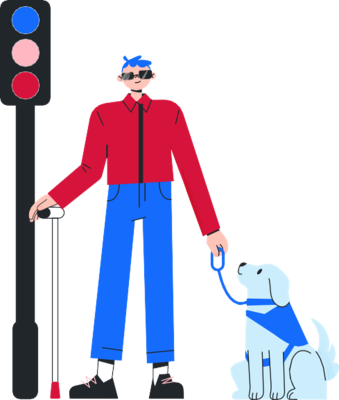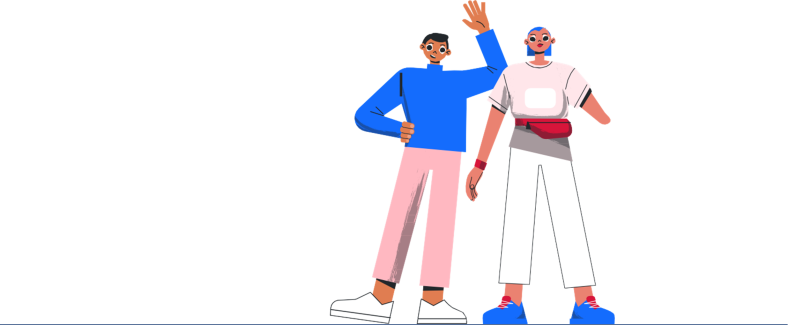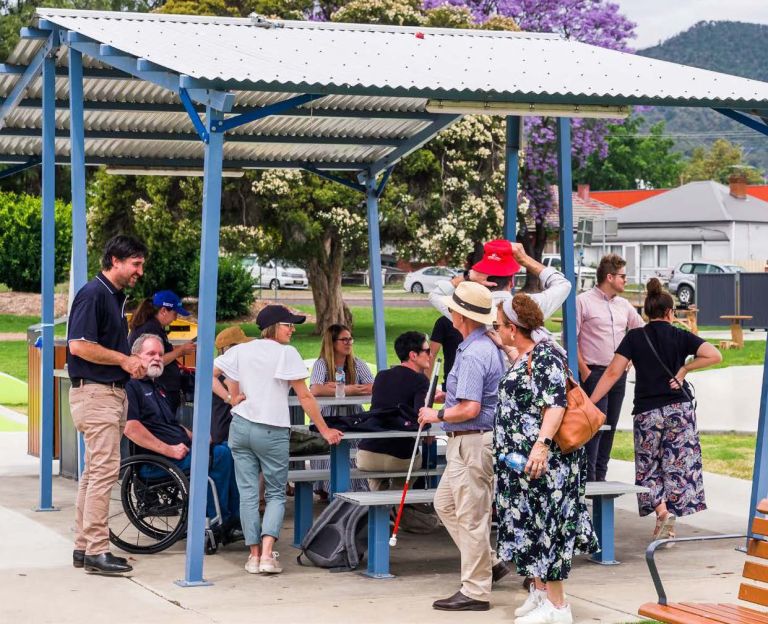About the department
Our mission is to protect, support and develop the primary industries and regional economies of NSW.
We protect through our regulatory, compliance and safety functions, and our conservation, natural resource management, and biosecurity services.
We support through our extension, education, advice and response functions.
We develop by researching, facilitating, encouraging and investing in opportunities.
Understanding disability
To effectively design and implement the actions in our DIAP, it has been important to understand the fundamentals of disability inclusion. The following principles underpin the development of our DIAP.
Social model of disability
The NSW Government has a consistent, contemporary definition of disability. Disability includes long-term physical, mental health, intellectual, neurological or sensory differences which, in interaction with various attitudinal and environmental barriers, may hinder full and effective participation in society on an equal basis with others.
The definition is based on the social model of disability, which recognises that people are disabled by physical and environmental barriers in society, such as buildings not having a ramp or accessible toilets, or by people’s attitudes, like assuming people with disability can’t do certain things.
The definition helps us recognise that it is these barriers that make life harder for people with disability and that removing these barriers creates equality and offers people with disability more independence, choice, and control.
Intersectionality of disability
Disability intersectionality is the idea that disability doesn’t stand alone. It is linked to other aspects of a person’s identity, like race, gender, sexuality, and socioeconomic status. People with disability might face different kinds of discrimination and challenges because of how these identities overlap. We also understand that living in regional NSW can create specific challenges, such as reduced access to education, jobs, and healthcare. Addressing these challenges requires customised approaches that are designed to meet the specific needs of these communities.
Person first language
Person first language focuses on the person rather than their disability. For example, we say, “a person with disability” instead of “a disabled person”. We
acknowledge not all people with disability will prefer this terminology and recognise that each person is unique. We respect an individual’s choice to identify themselves in the way that feels most appropriate to them.
Policy and legislative context
Disability legislation and standards ensure legal compliance, uphold the rights of people with disability, support advocacy, and guide effective resource allocation. Our DIAP was developed in line with the following legislation and standards:
- NSW Disability Inclusion Action Planning Guidelines
- NSW Disability Inclusion Plan 2021 – 2025
- United Nations Convention on the Rights of Persons with Disabilities
- Australia’s Disability Strategy 2021-2031
- Disability Discrimination Act 1992
- NSW Ageing and Disability Commissioner Act 2019
- NSW Disability Inclusion Act 2014
“Disability inclusion is not just something that happens at work, it is something that happens everywhere and should be considered and thought about everywhere.”
Employee

“Disability inclusion should be something we just do automatically.”
-Employee
“We need to bring lived experience into our policies and training.”
-Employee

Our commitment and approach
Guiding principles
Through the actions in our DIAP, we seek to become disability inclusive so that:
People with disability:
- feel valued and respected
- recognise the department as a great place to work
- receive equitable access to programs and services
- feel supported to participate in opportunities within their regional community.
Our department:
- continues to demonstrate a genuine commitment to disability inclusion
- continues to develop a more knowledgeable and confident workforce on inclusive practices that benefit our employees and communities
- treats everyone with respect and dignity, free from discrimination and harassment
- champions acceptance and equality
- is committed to transparency and accountability in disability inclusion efforts.
The community:
- recognises the department as an accessible and inclusive employer and service provider.
“Sometimes it’s not necessarily the big, shiny, expensive projects. Sometimes it’s the really simple, low- cost, high-impact things that can make a big difference.”
Employee

Data and consultation
Facts and figures
The PMES and Workforce Profile data shows that the number of people who disclose disability within the department does not match the number of reported people with disability in NSW and Australia.
A key focus of our DIAP is providing a workplace where individuals feel safe to disclose their disability and ensure they are recognised and fully supported within the department.
People with disability in the department also report lower favourable scores in the PMES in key topics including inclusion and diversity, wellbeing, communication and change management and learning and development when compared to other employee groups.
Our workforce
of our employees live in regional NSW.

(Workforce Profile Report 2024)
(PMES 2024)
(PMES 2024)
(PMES 2024)
(PMES 2024)
(PMES 2024)
NSW
(ABS 2018)
(ABS 2018)
(id 2021)
Australia
(ABS 2018)
(ABS 2018)
(Hill et al. 2021)
(ABS 2018)

Consultation
In developing our DIAP, we conducted internal and external engagement through multiple channels, including surveys, focus groups, and a review of key documents and policies.
We connected with a diverse range of individuals, such as people with lived experience of disability, carers, and members of our employee networks, with a particular emphasis on our DEN. Additionally, we engaged with senior leaders, employees and community members.
These discussions provided valuable insights into the lived experiences of people with disability.
We are grateful to everyone who participated in our engagement process and contributed invaluable insights to the development of the DIAP. We remain dedicated to a collective commitment to inclusion through ongoing engagement throughout the implementation of our DIAP, ensuring continued feedback and collaboration.
Several key themes emerged, directly influencing the actions in our DIAP:
There is a strong need to build greater awareness of disability in the workplace to foster safe, stigma-free environments where individuals feel comfortable discussing their disability and accessibility needs.
Stakeholders emphasised the importance of well-documented and consistently communicated approaches to ensure employees with disability are supported effectively in the workplace.
Improving workplace accessibility by addressing physical and environmental barriers was identified as essential, particularly in recruitment and everyday participation.
There is a need to ensure that digital communications and ICT systems are accessible to all employees, including those in regional communities.
Establishing a clear and consistent process to engage with people with disability when designing and implementing programs related to disability inclusion is critical.
There is a need for greater focus on educating the workforce about non- visible disability, with particular emphasis on neurodiversity.
Our actions
We commit to continuously learn about the needs of people with disability and evolve our approach and practices to ensure we are responsive
to these needs.
We recognise ongoing engagement with and input from people with disability is vital to the successful implementation of our DIAP.
Our DIAP supports the recognition and removal of barriers to equitable participation.
It guides impactful action through our collective commitment to inclusion, resulting in meaningful and sustainable change across the 4 key outcome areas of:
- positive attitudes and behaviours
- liveable regional communities
- inclusive employment
- accessible and inclusive systems and processes.
Monitoring and reporting
The success of our DIAP will be evaluated through qualitative and quantitative measures, including:
- clear outputs and outcomes for each initiative to ensure progress can be tracked and actions successfully completed
- monitoring and reporting progress in alignment with government, legislative, regulatory and compliance requirements
- regular engagement with employees who contributed to the development of our DIAP to gather feedback and guide future directions
- registering our DIAP with the Australian Disability Rights Commission
- highlighting achievements in the department’s Annual Report
- analysing PMES results and other workforce data to identify trends, areas for improvement and actions needed.
Our DIAP is available on the department’s website in HTML format and available for download in an accessible PDF.

Glossary and references
Acronyms and terms used throughout this action plan:
DEN: The Disability Employee Network champions the inclusion of people with disability and carers within the department to create a more inclusive and supportive work environment.
DIAP: Disability Inclusion Action Plan.
DPIRD: Department of Primary Industries and Regional Development.
Employee Network: At DPIRD, employee networks are voluntary groups formed around shared characteristics or interests to enhance the workplace experience of a particular group of employees.
PMES: The annual NSW People Matter Employee Survey asks NSW public sector employees about their experience and perceptions of a range of workplace issues and practices, including diversity and inclusion. The survey is conducted by the Premier’s Department with assistance from NSW public sector agencies and Ipsos, an external service provider. The summary results of the survey help agencies identify elements of good practice and areas in need of further improvement.
Workforce Profile: The Workforce Profile includes demographic information such as age, gender and diversity group membership, and employment information. The Workforce Profile supports benchmarking, workforce planning and employment policy development work at both agency and sector-wide level. It provides insight into social or economic trends and the composition of the sector’s workforce, the need for new employment policies, procedures or systems, and the impact of policies that are introduced. The disability disclosure rate includes all DPIRD employees, including Local Land Services (LLS), Rural Assistance Authority (RAA), Regional Growth NSW Development Corporation (RGDC).
NSW Public Service Commission (unpublished), Approved Workforce Profile Report 2024
NSW Public Service Commission (2024), NSW People Matter Employee Survey 2024
ABS (Australian Bureau of Statistics) (2018), Disability, Ageing and Carers, Australia: Summary of Findings, ABS, accessed 20 September 2024.
.id (Informed Decisions) (2021), Regional NSW Community Profile: Need for assistance, id, accessed 20 September 2024.
Hill A. O, Lyons A, Jones J, McGowan I, Carman M, Parsons M, Power J, and Bourne A, (2021) ‘Writing themselves in 4: The health and wellbeing of LGBTQA+ young people in Australia’. National Report, Australian Research Centre in Sex, Health. and Society, La Trobe University.

